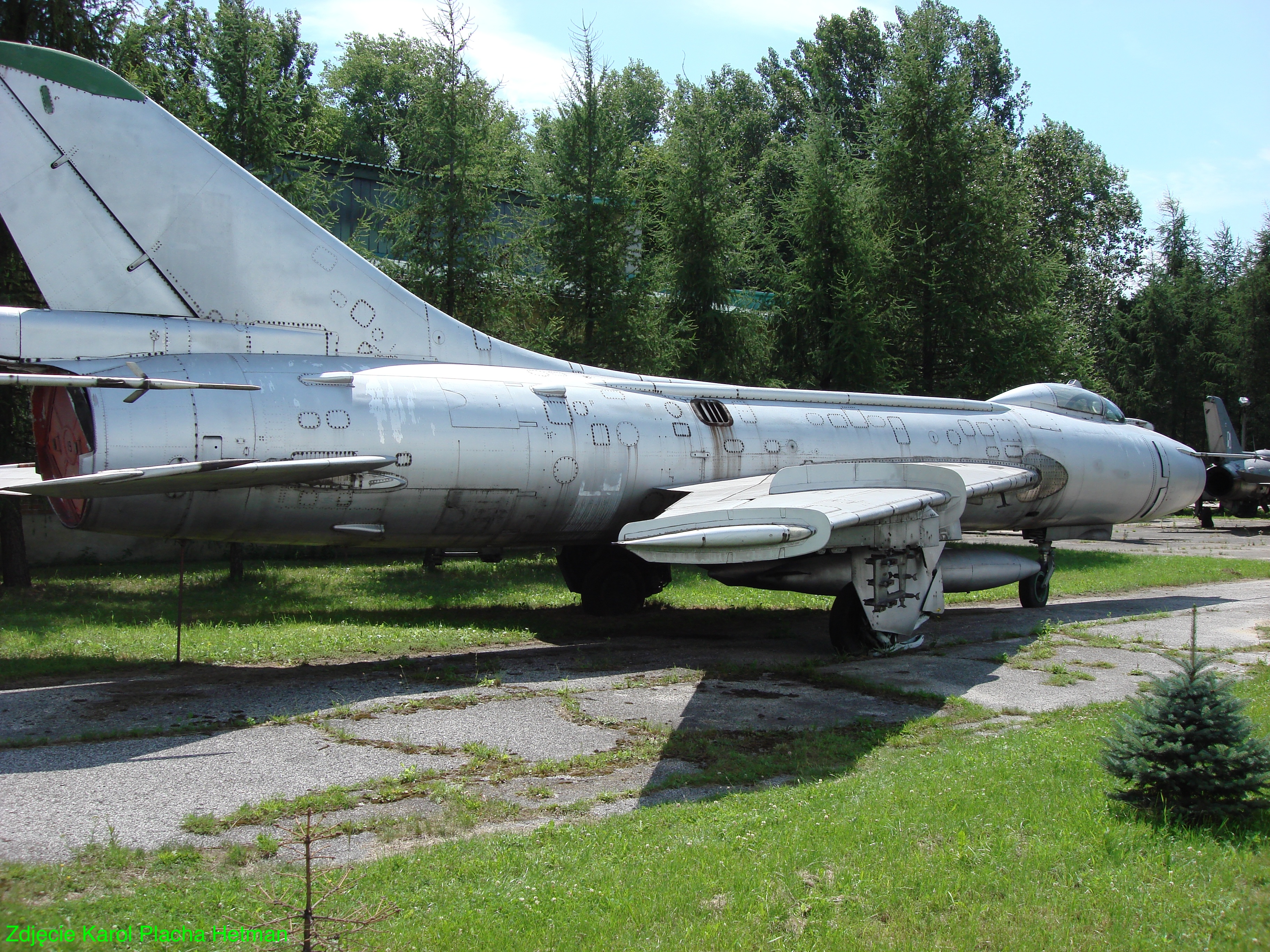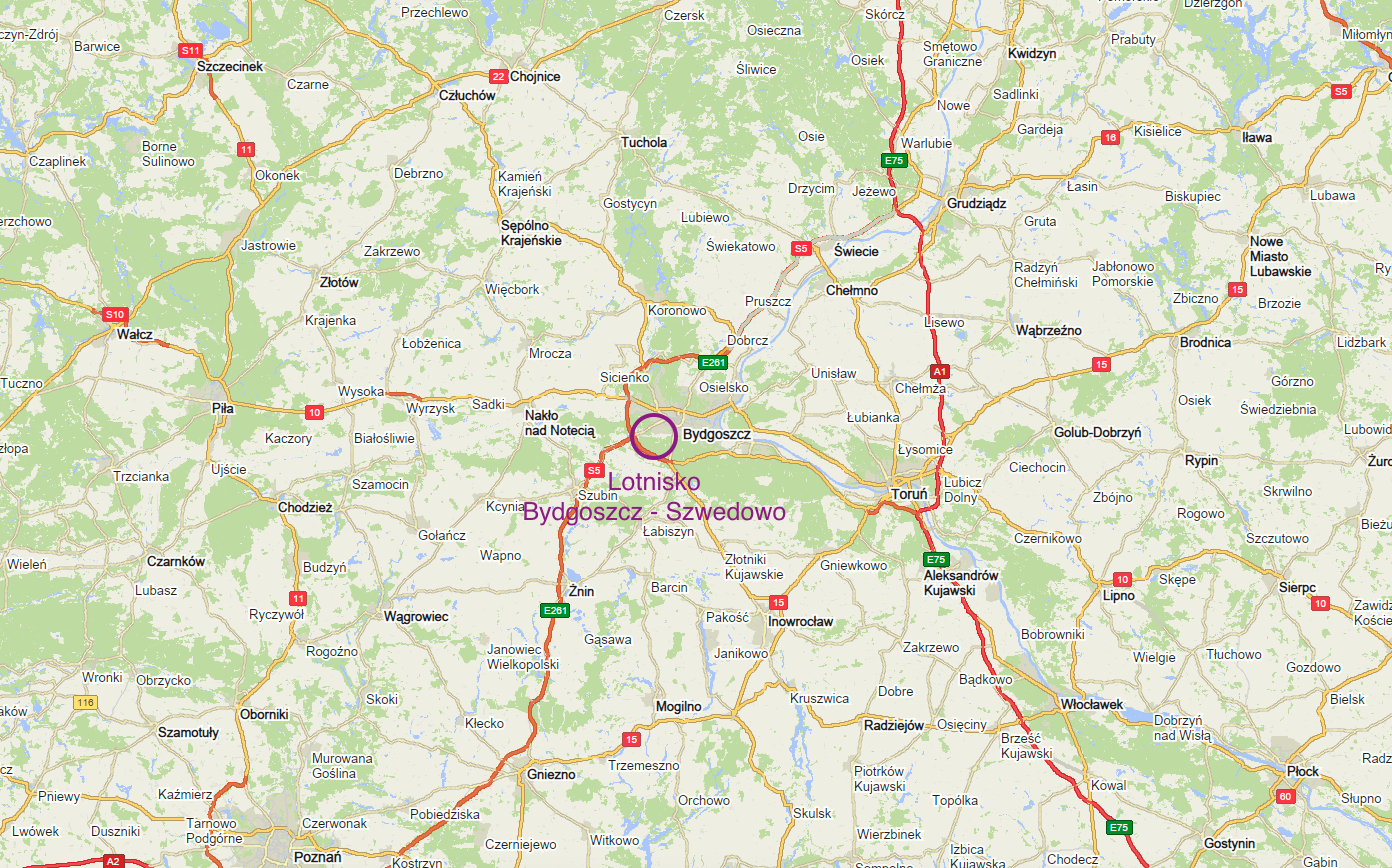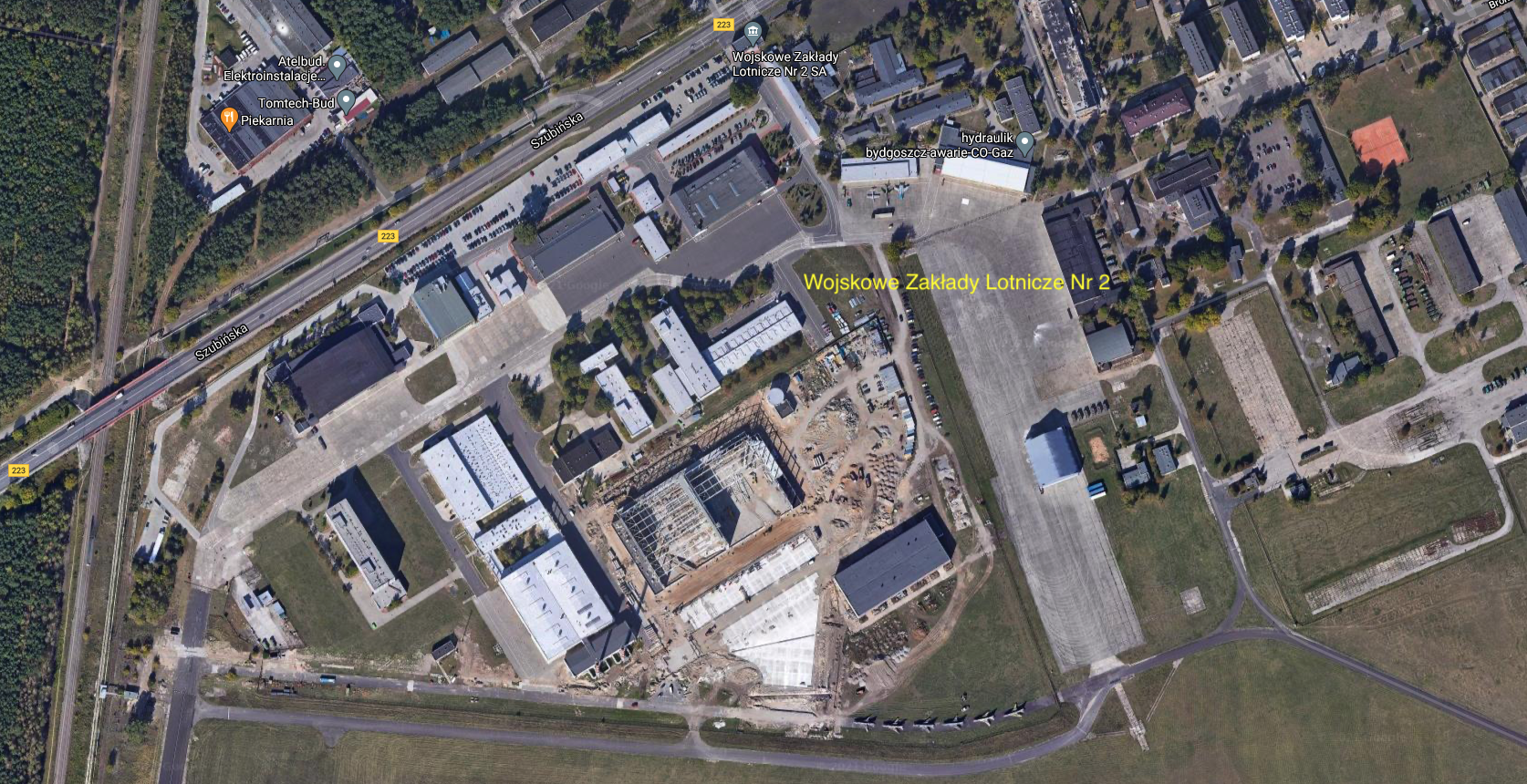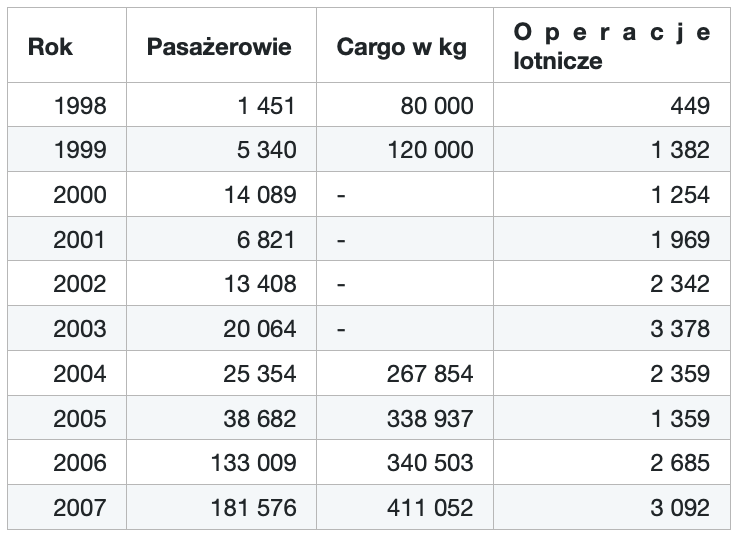Bydgoszcz 2013-01-18
Airport in Bydgoszcz - Szwedowo.
Geographic coordinates: 53.096N 17.978E. Elevation 72 m.


Further history of the airport in Bydgoszcz.
On March 6, 1992, the 3rd Pomeranian Training and Combat Aviation Regiment was disbanded. It was still hoped that the mass production of PZL I-22 Iryda training and combat aircraft would be possible, which could reactivate the unit. However, this did not happen. In place of the combat unit, a transport and liaison unit was created. Currently, the airport in Bydgoszcz is the International Airport named after Ignacy Jan Paderewski Bydgoszcz.
Air transport and liaison unit.
The combat unit was not the only air unit based at the Bydgoszcz Airport. In 1951, the 10th Independent Artillery Fire Correction Squadron was formed. In 1956, the 10th SEKOA lost its tasks and was transformed into the 10th Independent Liaison Aviation Squadron. In 1962, as a result of the new organization of military aviation, the 10th SELL was transformed into the 3rd Liaison Aviation Squadron and the 43rd Aviation Squadron of the OPK Troops. Both squadrons operated side by side until 1992, when the Air Force and the OPK Army were merged. Then both units were merged again, creating the 2nd Aviation Squadron. Some of the personnel from the disbanded 3rd Pomeranian Training and Combat Aviation Regiment were also transferred there. Within its structures, the first Aviation Search and Rescue Group in Poland was formed. When the Republic of Poland joined NATO, the 2nd Aviation Squadron on April 1, 1999 became the 2nd Transport and Liaison Aviation Squadron (JW 3290). This squadron consisted of 100% professional soldiers. On June 30, 2010, the 2nd ELT-Ł was disbanded and part of the unit's staff and equipment was transferred to the 33rd Transport Aviation Base in Powidz. Over the course of 59 years, the unit secured the operation of the regiments stationed here, and from 1992 to 2010, the 2nd Air Base.
Other military units related to aviation.
The Bydgoszcz Airport Base was the location of the headquarters of the National Air Defense Corps in the period 1957 - 2007. For 50 years, the Independent Anti-Aircraft Artillery Regiment of the Air Defense Force operated here, for which the 10th SEKOA (Independent Artillery Fire Correction Squadron) performed flights. Also in the 1950s, the Independent Observation and Reporting Regiment of the Polish People's Army was here. There has been a communication node here for 50 years, which in the period 1969 - 2007 was called the 2nd Communications Node. In the years 1974 - 2006, the 2nd Radio Engineering Brigade operated here, which had its beginnings 50 years ago as a radio engineering company.
2nd Air Base "Bydgoszcz". 1992.
The 2nd Bydgoszcz Air Base operated from 1992 to 2010 as Unit 3033. The base was established on May 2, 1992, pursuant to the order of the Chief of the General Staff of the Polish Army of January 3, 1992. The unit was formed on the basis of the disbanded 3rd Pomeranian Aviation Training and Combat Regiment and the Administrative and Economic Department of the 2nd Air Defense Corps. After its creation, the Base was subordinated to the commander of the 2nd KOP until the corps was disbanded in 2007. Then the base was subordinated to the 3rd Transport Aviation Brigade in Powidz (reformed in 2008 into the 3rd Transport Aviation Wing. Based on the decision of the Ministry of National Defense, the 2nd Air Base was disbanded on June 30, 2010.
Military Aviation Works No. 2.
In 1945, Wojskowe Zakłady Lotnicze No. 2 was established at the military airport in Bydgoszcz, with its roots reaching back to the Aviation Field Workshops of the interwar period. Due to the development of the plants, the Bydgoszcz airport was significantly modernized: among others, an almost three-kilometer runway as well as barracks and logistics facilities were built. The plant carried out renovations of combat aircraft.
Due to the very small number of twin rudders for training MiG-15 UTI fighter pilots, an opportunity arose to convert Lim-1 (single-seat) aircraft to SB Lim-1 (two-seater). Since the WSK Mielec production plant was not able to perform these modifications in a timely manner, it was decided to entrust this task to LZR in Bydgoszcz. All Polish two-seat Lim planes were created at LZR in Bydgoszcz by rebuilding the existing single-seat Lim-1, Lim-2. Polish double rudders differed significantly from the Soviet ones. The radio-electronic equipment and weapons were different. The modifications were carried out according to Polish rationalization projects of the Air Force technical staff. Therefore, the structure was also different. It was also possible that two-seater units were built from two different machines. For example, the front part is made of Lim-1 and the rear part is made of Lim-2. From 1958 to 1960, approximately 147 machines were converted to SB Lim-1. One of the first was the copy that received No. 1A 06-023 and left LZR-2 in Bydgoszcz in July 1958, going to the 13th PLM in Łęczyca. In 1960, 18 Lim-1 were rebuilt into SB Lim-1. In 1961, 23 Lim-1 were rebuilt into SB Lim-1, of which 8 were sold to Hungary. In 1962, another dozen Lim-1s were rebuilt as SB-Lim-1s. Several of these machines were sold to Hungary, and the rest went to Polish units, mainly to the 21st SPLR in Sochaczew. In the period 1963 - 1964, about 50 Lim-1 machines were rebuilt on SB Lim-1. In the period 1965 - 1966, 35 Lim-1 machines were rebuilt into SB Lim-1. Of these, 25 machines went to Polish units, mainly to Dęblin and Nowe Miasto nad Pilicą. The remaining 10 pieces were sold abroad.
Airframes were renovated in Bydgoszcz; MiG-17, Lim-5/6 bis, MiG-19, MiG-21, TS-11. New installations were installed. Maintenance and painting were carried out. Wojskowe Zakłady Lotnicze No. 2 is still operational (2021). They repair airframes and aircraft equipment; Su-22, MiG-29, TS-11, M-28 and others. Also other countries.

Air Ambulance Service.
One of the aviation units established in Bydgoszcz was the Sanitary Aviation Team (Air Emergency Service). It was established in 1955 as one of four branches in Poland, next to Kielce, Lublin and Katowice. The facility from Bydgoszcz used 6 domestic airports in; Bydgoszcz, Fordon, Toruń, Inowrocław, Grudziądz and Lisie Kąty.
For many years, the Air Ambulance Service in Bydgoszcz was located in rented premises of the post-military Bydgoszcz-Szwedowo airport. Plans to build a new base have existed for 90 years, but there were problems with the location. Ultimately, the choice fell on a new area, outside Bydgoszcz, on National Road No. 5, near the road junction of the S5 Bydgoszcz bypass. It was a plot of land owned by the LPR. The new HEMS base is located approximately 12 km north of Bydgoszcz. Its construction took 12 months. Its cost is PLN 9.7 million. Address Lotnicze Pogotowie Ratunkowe, Bydgoszcz Branch, ul. Szosa Gdańska 31, 86-021 Żołędowo. The HEMS base in Bydgoszcz is one of 21 permanent HEMS bases in Poland. It carries out approximately 500 missions annually.
On November 25, 2020, the new HEMS (Helicopter Emergency Medical Service) base in Bydgoszcz was opened and began its duties. The new building has an area of 710 m2. There are operational, social and storage rooms and a helicopter hangar. The base is equipped with a fuel station and an electric platform on which the helicopter is deployed and stowed from the hangar without the use of a tractor. The EC.135 helicopter crew consists of a pilot, a paramedic/nurse and a doctor. Duty hours are regular from 7:00 a.m. to 8:00 p.m. Helicopters are most often used for traffic accidents and sudden illnesses, such as myocardial infarction or stroke.
Air Show in Bydgoszcz.
Air shows called Air Show were held twice at Bydgoszcz Airport, which started with shows at Ławica Airport in 1991. Their organization was related to the celebration of Polish Aviation Day. The first show in Bydgoszcz took place in 1996, on August 24-25, 1996. The following planes and teams presented themselves in flight; Biało-Czerwone Iskry TS-11 - 9 pieces, Biało-Czerwone Iskry TS-11 - soloist, MiG-29 4 machines from Mińsk Mazowiecki, An-26 paratrooper drop, Mi-24 - team of 4 machines, W-3 Sokół - soloist , PZL-130 Orlik - soloist, MiG-29 - soloist, Mirage 2000 - soloist France, Tornado - soloist Germany, F-16 - soloist USA, F-18 - soloist USA, TS-8 Bies - soloist.
The following year (1997) shows were held under the name; 2nd International Air Show Bydgoszcz 97. They were also related to the Polish Aviation Day. They were carried out on August 28-31, 1997. Presented; J-35 Draken from Sweden, Gripen from Sweden, Su-27 (Russia, Aleksander Kwoczur demonstrated the figures: a bell and a cobra in the air), Mirage 2000 two-seater from France.
Passenger and freight traffic.
Bydgoszcz, like other Polish cities, strived to maintain permanent air connections with cities in the country and abroad. But there were always major obstacles and often, as soon as a newly opened connection was launched, it was suspended. Already in 1945, a connection was launched on the Warsaw-Bydgoszcz-Koszalin route. They were operated by Li-2/DC-3 aircraft. In 1948, this connection was changed to the Warsaw-Bydgoszcz-Gdańsk line. They were maintained until 1958. In the following years it got worse. PLL LOT flew to Bydgoszcz sporadically. Only in 1969, LOT Polish Airlines opened the Bydgoszcz airport. In 1969, regular flights to Warsaw and seasonal flights to Gdańsk and Poznań were launched again. They were operated by newly acquired An-24 aircraft. In 1973, a regular connection with Krakow was launched. Martial law introduced by the communists led first to the suspension of flights and then to the liquidation of the Bydgoszcz airport station.
The civil airport in Bydgoszcz was reactivated in 1989 as a result of the socio-economic changes taking place in the country. In order to open the airport, Bydgoska Korporacja Lotnicza Sp. was established. z o. o., which operated until June 1995, when it was transformed into a joint-stock company. In 1992, civilian charter connections were reactivated, and in 1996, regular flights to Warsaw were launched. The connections were served by ATR-42/72 aircraft. A significant achievement of the company was the transformation of the regional airport in Bydgoszcz into an international airport. The Bydgoszcz airport received a license from the Minister of Transport and Maritime Economy and a "Polish Qualification Certificate" issued by the Chief Civil Aviation Inspectorate and a public use airport certificate authorizing the management of the airport within the meaning of the Aviation Law of 2002. On May 1, 2004, the new passenger terminal building was opened. Since November 2004, the civil airport has been named after Ignacy Jan Paderewski.
In the period 2003 - 2004, the first Polish low-cost airline Air Polonia provided the first air connection with foreign countries, serving the Bydgoszcz - London (Stansted) connection.
A real revolution for Bydgoszcz Airport came when the low-cost airline Ryanair appeared here in 2005. It ensured direct contact between the inhabitants of Bydgoszcz and the surrounding area not only with London, but also with other ports. Ryanair's advantage was and is its attractive price. Low costs result, among other things, from the fact that the company operates one type of aircraft; Boeing B 737. In addition, as many as 97 percent of reservations are made via the Internet. There are ten thousand passengers per employee, ten times more than in other airlines.
In 2008, the Polish aviation company Jet Air launched a connection with Warsaw using BAe Jetstream 32 aircraft, as well as from Bydgoszcz to Babimost. However, Jet Air, as well as another Polish company YES Airways, were incorporated into OLT Germany and liquidated (2012).
On March 10, 2008, the new shareholder of Port Lotniczy Bydgoszcz SA was the Austrian company Meinl Airports International Ltd. (MAI), which agreed to invest EUR 23.5 million in the expansion of the airport. In the first phase, MAI received a block of shares equal to 24.9%, and ultimately acquired 49% of the shares. Thus, the airport in Bydgoszcz became the first and only airport in Poland where a foreign investor had shares. In January 2009, the Austrian company Meinl Airports International Ltd. sold a block of shares (48.98%) of the Bydgoszcz Airport to the German company Airport Internacional. Fortunately, in 2010, the majority stake of shares was purchased from it by the local government of the Kuyavian-Pomeranian Voivodeship.
On September 9, 2011, the millionth passenger of the Ryanair airline was checked in at the airport in Bydgoszcz. In October 2012, passenger numbers officially exceeded 300,000 passengers for the year.
Bydgoszcz International Airport.


International Airport. Ignacy Jan Paderewskiego Bydgoszcz (IATA code: BZG, ICAO code: EPBY). It is the 9th busiest airport in Poland. Currently, it has 21 air connections: 6 permanent international connections, 14 charter connections (summer 2012) and 1 domestic connection with Warsaw. In 2008 MPL Bydgoszcz recorded the highest increase in the number of checked-in passengers of all airports in Poland, amounting to 54.07% compared to 2007. Located approximately 3 km from the center of Bydgoszcz, in the Szwederowo estate, therefore known as Bydgoszcz-Szwederowo Airport. The port is located in the southwestern part of Bydgoszcz, partly within the Białe Błota commune. From the south, east and west it is surrounded by the Bydgoszcz Forest, and from the north it borders the Bydgoszcz settlements: Szwederowo and Górzyskowo. The airport is prepared to accept and service passenger, transport and military aircraft, provided they require a takeoff roll or landing roll within 2,500 m. Bydgoszcz Airport boasts one of the most beautiful passenger terminals in Poland. The modern building of the Airport in Bydgoszcz was awarded in the prestigious competition for "Building of the Year 2004". Passengers traveling from Bydgoszcz Airport have newsagents, currency exchange offices, ATMs and car rental points at their disposal. Before departure, you can also do duty-free shopping in Baltona chain stores and drink coffee at the airport coffee bar. A restaurant will soon be opened in the Bydgoszcz Airport terminal. At the Bydgoszcz airport you can use free WiFi and specially prepared internet kiosks. The entire passenger terminal is air-conditioned and equipped with electronic monitoring, fire protection and access control systems.
The terminal in Bydgoszcz has an area of 7,000 square meters and a capacity of 500,000 people per year. It also has 7 check-in stations. 2 gates - one international with passport control stations and one for local traffic. RWY with dimensions of 2,500 m x 60 m, direction 08/26. load capacity PCN 46 F/B/X/T. Height 72 m above sea level.
The airport also has three other RWYs, with a dirt surface, used by sports aviation, tourist aviation and general aviation. Grass; 590 m x 100 m Direction 03/21. Grass, 650 m x 100 m Direction 08L/26R. Grass, 650 m x 100 m Direction 12/30. Grass roads have a load capacity of MTOM 5,700 kg.
The airport is equipped with: navigational lights: On direction 26, Calvert approach system (825 m), LIH, 3 intensity levels. On direction 08, simplified approach system "cross" (420 m), LIH, 5 intensity levels. On directions 26 and 08, PAPI lights at 3.5 intensity levels. Radio navigation aids: ILS/DME system BYD 109.100 MHz, NDB BDG 388 KHz, weather cover: airport MET station, Vaisala automatic measurement system.
It was planned (after 2012) to build a cargo terminal, rebuild the apron and build a new apron for aircraft, rebuild the runway with taxiways along with drainage and lighting, build an aircraft de-icing station, rebuild the passenger terminal (build a third departures hall there) , changing the ILS category to the second one and increasing the check-in counters from 7 to 10.
Written by Karol Placha Hetman
